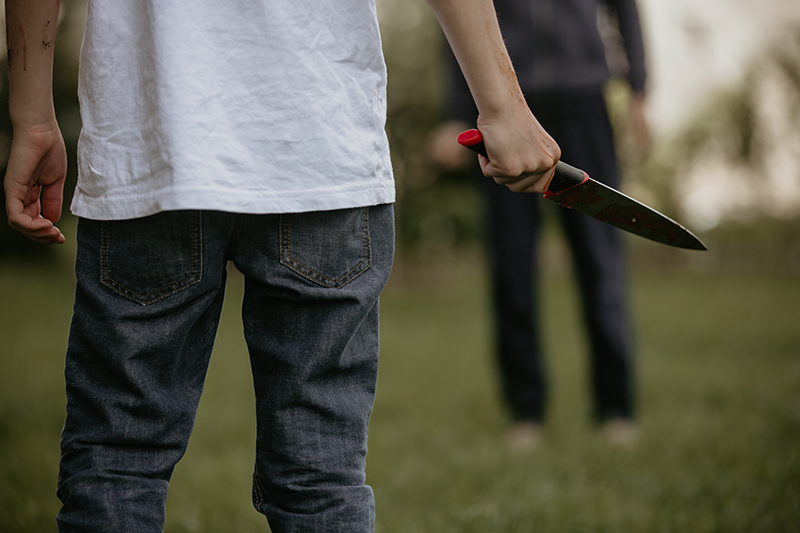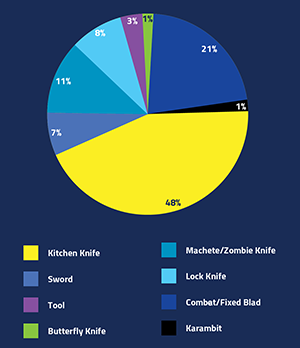The Metropolitan Police, working in collaboration with academics from Surrey University, are using artificial intelligence (AI) to tackle knife crime in London and prevent it in the first place.
The innovative project has harnessed the power of AI to accurately match a knife to a crime and trace its origin.
The details were used to create a core database of knives, but the knives were also photographed in different lighting, angles, alongside other objects and in different background conditions to replicate real life conditions.
By leveraging AI to identify which knives are being used in crime, they can collaborate with retailers via the Responsible Retailer Scheme to prevent future sales of such knives and target enforcement activity if needed.
According to Matt Turner, Chief Inspector at the Met and the driving force behind the project, one of the main barriers in solving knife crime has been not knowing the origin of the knives used in crimes.
Professor Miroslaw Bober, from the University of Surrey, explains that with over 49,000 knife-enabled offences in the UK each year (according to the latest Office for National Statistics figures), it is too laborious to investigate the supply and provenance of each knife that is encountered or seized and match it to a crime manually. Here the colossal processing power of AI has proved vital.
AI, particularly in the field of image recognition, presents multiple benefits for the identification of knives. It is capable of processing large volumes of images swiftly and effectively, which enables quick analysis of photographic databases and surveillance videos.
The University of Surrey Centre for Vision, Speech and Signal Processing is a world leader in image recognition software. Over a 12-month period, Chf Insp Turner, in collaboration with Prof Bober and his team, developed the world’s first AI bladed weapon analysis system for policing.
This groundbreaking system includes a cutting-edge AI engine, a bespoke user interface, and the related cloud-based infrastructure, providing police officers with on-demand access to the system when needs arise.
Developing an AI system to recognise knives means the creation of a database of knives known to the police. Utilising partnerships with responsible retailers of knives, Chf Insp Turner and his team visited and captured details of knives for sale to the public. They also visited evidence storage units in the Met, to see real knives that had been used in crime and taken off the streets.
Details captured included the blade length, materials used in manufacture, colour, and details of retailers. The details were used to create a core database of knives, but the knives were also photographed in different lighting, angles, alongside other objects and in different background conditions to replicate real life conditions.
Crucial to delivering a system with accuracy, this work produced a database of over 20,000 images and 500 knives.
Testing the AI Concept
In May 2023, the AI image recognition system was trialled nationwide as part of Operation Sceptre, the knife crime intensification week. The product of the Knife Recognition AI project is a website where officers either take a photo in real time or to upload a previously taken photograph.
The system then uses an AI image recognition algorithm to match the photo of the knife taken by the officer to one in the database, or at the very least, classifying the type of knife into one of eight categories (see left).
During Operation Sceptre, the system was live for all police forces to test its ability to recognise items correctly. During the operation, 570 images of knives from police forces across the UK were recovered from live operations and were submitted to the system. In instances where the knife was present in the database, it was recognised and correctly categorised 99.2% of the time.
Chf Insp Turner said: “The trial proved that the system clearly worked. The AI software was able to identify the type of knife and it could work with a variety of photographs, even difficult images taken in the back of police cars or in the middle of the night on a wet and poorly lit street.”
Chf Insp Turner and his team are also looking to produce a dashboard to provide knife crime leads in each police force with an overview of how the AI knife image recognition system works, and information which explains patterns and trends in knife crime.
He explained that now the challenge is providing a much bigger database that the AI image recognition system can work from. Working with suppliers, retailers, manufacturers and importers, he and his team are building their knowledge of the knives out on the market.
The system can identify the provenance and types of knives being used in criminal activity. This information can be presented to manufacturers and retailers when their knives have been found in police incidents to prevent future sales.
Continuing to work with Surrey University, Chf Insp Turner and his team are also looking to produce a dashboard to provide the knife crime leads in each police force with an overview of how the AI knife image recognition system works, and information which explains patterns and trends in knife crime.
In the longer term, if successful, they will be looking to roll out the project nationally, but as he explained, “there is still a long journey to go to take this proof of concept into everyday policing”.
Collaboration fostering opportunities
Working with academia has opened up more opportunities for the police to find a way forward while benefitting from the ‘greater flexibility to try new things’ that academics enjoy.
Chf Insp Turner explained: “From my perspective, often in policing we pile in resources but come up against various hurdles or red tape. But, if we work with a partner in science and technology then we can get a quicker solution, and something more efficient.”
We realised how dangerous it is for society – most attacks not pre-planned, and the availability of knives increases the likelihood of violent crime – so the work we are doing to reduce knife availability is vital.”
Professor Miroslaw Bober,
University of Surrey
There are opportunities to see the issue from a different perspective for academics too. Prof Bober said: “It’s been amazing to work on this. Obviously, I knew how dangerous the issue of knives was but didn’t know about the huge volume.
“The team brought us to a warehouse, and we saw thousands of knives in huge crates, it was shocking. We realised how dangerous it is for society – most attacks not pre-planned, and the availability of knives increases the likelihood of violent crime – so the work we are doing to reduce knife availability is vital.”
Prof Bober noted that using technology can free up time and make policing more efficient. Recognition technology can be overlaid to assist people threatened at home, and mapping technology can be used to track where knives are coming from and where they are going.
The project is not only aiming to reduce knife availability on the streets, but is also saving time and using technology to make policing more efficient. The team’s efforts to reduce knife crime in London are a testament to the power of cross-sector collaboration in addressing complex social challenges.
This article first appeared in Policing Tomorrow, the magazine of the Office of the Police Chief Scientific Adviser, and is republished under a Creative Commons Licence; you can read the original here.
Picture © Tomsickova Tatyana / Shutterstock



